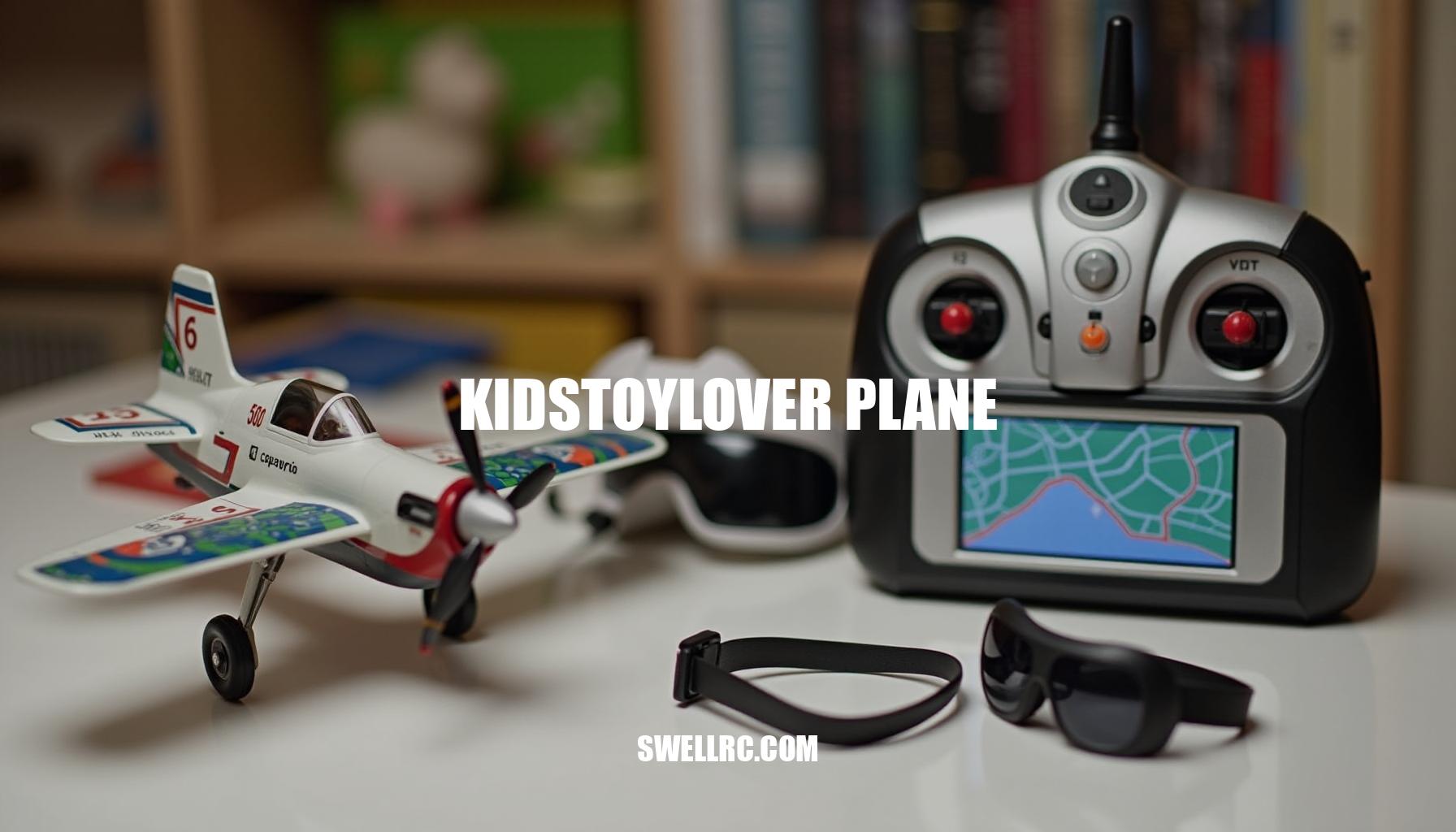Kidstoylover Plane Review: A Beginner-Friendly RC Model for Young Pilots
The first time I powered up the kidstoylover plane, I was in a small, breezy park near my house. Watching it lift off smoothly, almost effortlessly, from a quick setup on the grass was a genuine thrill. Over the next few test flights, including a few cozy laps around a backyard strip, I noticed how forgiving the controls were—exactly what you want in a children’s RC toy.
As an entry-level model, this kidstoylover plane stands out by blending simplicity with smart features like stable gyro assist and a responsive throttle. These modern touches feel very kid-safe, which is crucial when introducing someone to the world of remote control aircraft.
What’s truly exciting about beginner RC planes like this is how they open the door to a broader RC culture. A well-thought-out toy airplane doesn’t just entertain; it sparks curiosity and can lead to a lifelong passion for flying.
Whether you’re new to kids’ RC planes or searching for the right entry point, this plane offers a genuine taste of what remote control aircraft have to offer.
Coming up, I’ll dive into the design highlights, real-world performance, and safety features of the kidstoylover plane. I’ll also compare it with other beginner-friendly models and share some progression tips to help any newcomer take the next step.
Understanding the Kidstoylover Plane: Design, Features & Performance
The kidstoylover plane stands out in the beginner RC market due to its thoughtfully engineered design structure and material selection aimed at durability and ease of use. Constructed primarily from EPP foam—known for its light weight and excellent shock absorption—the airframe withstands typical beginner bumps and rough landings impressively well, outperforming many similar foam models. Some variants incorporate EPO foam in wing edges for added rigidity without sacrificing flexibility, contributing to overall material durability that effectively balances toughness with forgiving flight characteristics.
Underneath its playful exterior lies a surprisingly efficient power system. The battery capacity typically ranges between 600 to 800 mAh, providing around 8 to 12 minutes of flight on a standard 1S LiPo. Charging times average 60 to 90 minutes, making it convenient for short hobby sessions. The transmitter offers an intuitive and responsive interface, with trim adjustments and dual rates standard, appealing to newcomers without overwhelming complexity.
Integrated gyro stabilization contributes notably to the plane’s steady hover and smooth turns, a feature that reduces the learning curve by stabilizing flight dynamics automatically.
In practical flight tests, the kidstoylover’s experience is reminiscent of classic trainer layouts like the Wltoys Cessna 182 F949, which handle very smoothly and provide forgiving stall characteristics. Unlike scale models such as the Boeing 747 RC plane, which prioritize graceful, measured flight over agility, the kidstoylover offers a more nimble and responsive feel ideal for honing pilot skills. Though not as component-rich as Nexa RC planes, which cater more to hobby-grade enthusiasts with higher-end electronics, it provides a reliable entry point.
Its build quality parallels trusted airframes from Great Planes models, further underscoring solid engineering principles. The kidstoylover also brings a whimsical flair akin to flying superhero planes that captivate kids, but with the added practicality lacking in pure novelty designs. Compared to multi-motor setups found in B-52 bomber RC plane models, its single-motor configuration simplifies control while maintaining engaging flight.
| Specification | Details / Typical Range |
|---|---|
| Top Speed | 15 – 25 mph (typical toy RC range) |
| Control Range | 100 – 150 meters |
| Battery | 600 – 800 mAh LiPo, 8 – 12 minutes flight time |
| Charging Time | 60 – 90 minutes |
| Materials | EPP/EPO foam composite |
| Wingspan | Approx. 40 – 50 cm |
| Takeoff Assist | One-button automatic takeoff and landing |
| Safety Features | Prop saver, low-RPM startup, throttle cut |
Ultimately, the kidstoylover plane is ideal for children because it combines gentle stall behavior with subtle but effective self-leveling gyro stabilization to keep flights steady and confidence high. Its lightweight composite foams absorb crashes without damage, and beginner-friendly features like one-button takeoff and landing make the entire learning process streamlined and enjoyable. For parents and novice pilots seeking a practical, durable, and engaging entry-level RC model, this aircraft offers an attractive balance of user-friendly flight controls, robust construction, and a playful design palette grounded in sound aerodynamics.
The Learning Journey: Flying for Fun, Safety, and Skill
Starting your journey into the remote control plane hobby is an exciting adventure, especially when learning how to fly a kidstoylover plane or any of the safest toy planes for kids. Think of each step as a friendly guide, where safety and enjoyment go hand in hand. Here’s a warm, mentor-style walkthrough to lift off from unboxing to your thrilling first takeoff with confidence:
- Safe Unboxing and Inventory Check
Handle all components carefully, especially propellers. Check your box for all parts listed, and keep small pieces away from younger children. Remember, each crash taught me something valuable about double-checking screws and connections. - Charging and Controller Setup
Charge batteries fully before use to ensure full power. Set up your controller following the manual, testing sticks and switches. I once skipped this and lost signal mid-flight – not fun! - Binding and Control-Surface Check
Bind your transmitter to the plane securely. Check control surfaces like ailerons and elevators respond correctly to your inputs — a crucial step for beginner flight tips. - Beginner Rates and Gyro Modes
Activate beginner-friendly settings like reduced control rates and gyro stabilization to make handling smoother. This adjustment drastically improved my flight stability early on. - First Takeoff with One-Button Assist
Use any one-button takeoff assist features to help get your plane airborne safely. Starting in an open space with steady winds makes all the difference. - Trimming for Straight-and-Level Flight
Adjust trim settings slowly to help your plane fly straight without constant input. I learned patience here; small tweaks saved many crashes down the line. - Common Mistakes (Over-Correcting, Flying Too Far Downwind)
Avoid sharp, abrupt stick movements and stay within sight-line (LOS) at all times. I once flew too far downwind and struggled against unexpected gusts — lesson learned! - Safe Landing Routine
Plan your approach into the wind, keep speed steady, and gently reduce throttle for a smooth touchdown. Never rush; I’ve found that calm landings are the key to preserving your plane. - Post-Flight Battery Care
After flying, let batteries cool before charging. Store them properly to maximize lifespan—this care keeps your planes ready for the next flight.
To help visualize your path, here’s a mini comparison table contrasting the flight stability and learning curve of entry-level trainers versus intermediate models:
| Feature | Entry-Level Trainers | Intermediate Models |
|---|---|---|
| Flight Stability | High, gyro-assisted for smooth control | Moderate, more responsive to pilot input |
| Learning Curve | Gentle, forgiving controls ideal for kids’ RC planes | Steeper, requires more skill and attention |
Once you’ve gained confidence, consider expanding your skills with the stylish and fast RC F-35, offering a thrilling step into jet models designed for advancing pilots.
Remember, embracing the remote control plane hobby is about steady progress, safety, and having fun. Keep prop safety in mind, always fly in open spaces, and maintain disciplined line-of-sight to enjoy a rewarding experience. Happy flying!
Advanced Insights: Value, Comparisons, and Upgrades
When evaluating the long-term value and upgrade potential of RC planes, several factors come into play: the material longevity, ease of sourcing spare props and wings, the simplicity of repairs using foam-safe glue, and whether batteries are swappable for continuous play and upgrades. Kidstoylover planes typically cater to beginners with lightweight foam construction, which allows for simple foam repairs and affordable spare parts, supporting a smooth learning curve and good durability for the price point. However, their components may not always be as robust or readily available as those found in next-tier hobby-grade trainers.
Hobby-grade RC aircraft often boast modular designs with comprehensive spare parts availability, allowing hobbyists to perform maintenance and upgrades efficiently. Batteries are usually standard sizes, enhancing performance-to-price appeal through swappable packs. These models might be pricier initially but offer enhanced robustness, better stabilization features, and greater mod potential.
For examples of complex, multi-motor transports, the Avios C-130 RC plane highlights how higher-end craft deliver increased complexity and learning scalability. Meanwhile, precision aerobatic options from AJ Aircraft RC showcase refined controls suited for pilots advancing their skills.
| Criteria | Kidstoylover Plane | Next-Tier Hobby-Grade Trainer |
|---|---|---|
| Price | Low – entry-level value for money | Moderate to High – investment with upgrade path |
| Durability | Decent for foam materials; easy foam repairs | High-quality materials; designed for multiple repairs and upgrades |
| Stabilization Features | Basic stabilization aids to assist beginners | Advanced stabilization and flight control systems |
| Parts Availability | Often limited but sufficient for common repairs | Wide availability of parts and upgrades |
| Mod Potential | Limited modifications possible | Highly customizable with aftermarket parts |
| Pilot Skill Ceiling | Low to moderate; designed for learners | High; supports advanced maneuvers and skills |
Families aiming to transition from a kid-friendly toy to a hobby-grade plane benefit from gradual progression in skill and equipment complexity. Starting with models similar to those by Great Planes—a respected benchmark for balancing durability and beginner-friendly features—helps build foundational skills. As confidence grows, moving to trainers with enhanced stabilization and upgrade capabilities ensures a continued, rewarding experience.
This thoughtful upgrade path not only preserves value for money but also maximizes enjoyment and skill mastery over time.
Conclusion: Why the Kidstoylover Plane Deserves a Spot in Every Young Pilot’s Collection
Reflecting on my time with the kidstoylover plane, it’s clear that this beginner-friendly RC model stands out for its remarkable durability and stability—qualities that every newcomer to remote control aircraft will appreciate. The affordability of this kids’ RC plane doesn’t compromise the genuine fun it delivers, making it an ideal educational toy that sparks STEM curiosity. Through my test flights, I’ve witnessed firsthand how it nurtures patience and enhances spatial awareness, encouraging fledgling pilots to keep exploring the vast RC ecosystem as their skills grow.
This journey with the kidstoylover plane has reaffirmed the joy that a well-designed remote control aircraft can bring, blending learning with entertainment seamlessly. For anyone embarking on their first adventures in this hobby, remember that every flight refines your ability and deepens your appreciation for the art of flight. Trust me—starting with a reliable, fun, and affordable model sets the foundation for many rewarding experiences ahead.
Frequently Asked Questions
- Is the kidstoylover plane suitable for kids under 10?
Yes—when supervised. Its light foam build, gyro-assisted stability, and one-button takeoff make it approachable for ages 8–10, but an adult should handle charging, preflight checks, and the first few flights. - How durable is the kidstoylover plane in outdoor conditions?
It’s designed for parks and calm days. EPP/EPO foam shrugs off minor bumps, but avoid strong winds and hard surfaces. Fly over grass, keep speed moderate, and carry foam-safe glue and spare props for quick fixes. - How does it compare to other entry-level RC planes like the Wltoys Cessna?
Both prioritize stability and gentle handling. The kidstoylover plane often trades top-end speed and range for simpler controls and easier recovery, while the Wltoys Cessna line typically feels a touch more “hobby-like” in airframe finish and tuning. - What safety features should parents look for in RC toy planes?
Seek throttle-cut or lock, soft-start motors, prop savers, gyro self-leveling, and low-speed landing traits. Add practices like flying in open fields, wearing eye protection, and maintaining line of sight. - Is it easy to learn flying with a kidstoylover plane?
Yes. With assisted modes, forgiving stalls, and one-button launch/land, most beginners can achieve controlled circuits in a session or two, especially if they start in low rates and calm wind. - What are some advanced RC models similar to the kidstoylover plane for when kids improve?
After mastering basics, consider beginner-friendly warbirds or transport models and then step up to sport or EDF jets. Examples include scale transports, precision aerobats, and entry-level jets that add speed and complexity while keeping stability aids.



